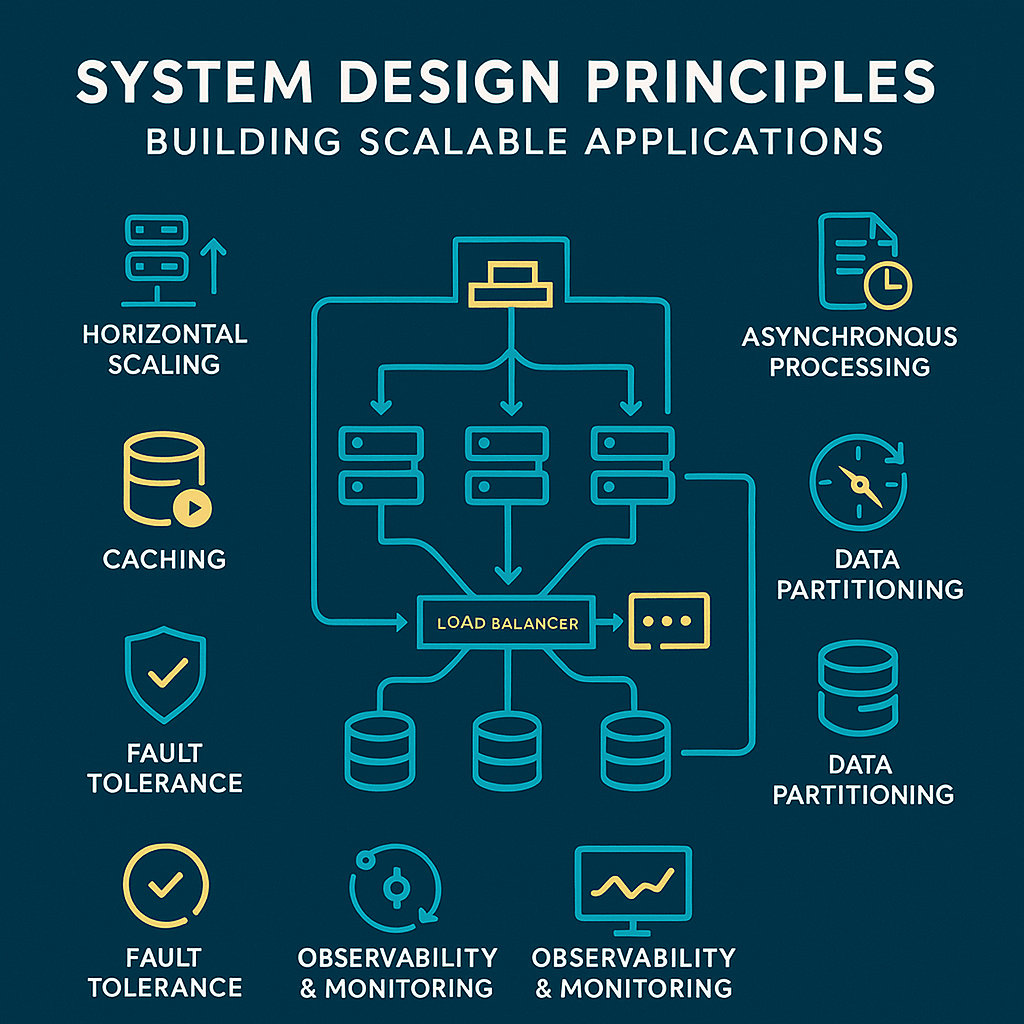System Design Principles: Building Scalable Applications
June 15, 2025 • 15 min read

System design is the art of creating robust, scalable, and maintainable software architectures. Whether you're building a simple web application or a complex distributed system, understanding fundamental design principles is crucial for success. This guide will walk you through the essential principles that every developer should know when designing systems.
What is System Design?
System design is the process of defining the architecture, components, modules, interfaces, and data for a system to satisfy specified requirements. It involves making high-level decisions about how your application will be structured, how components will interact, and how the system will scale over time.
Core Design Principles
1. Single Responsibility Principle (SRP)
Each component or service should have one reason to change. This principle helps maintain code clarity and makes systems easier to understand and modify.
Example:
Instead of having a monolithic user service that handles authentication, profile management, and notifications, split it into separate services:
- AuthService - handles login, logout, token management
- ProfileService - manages user profiles and preferences
- NotificationService - handles all notification logic
2. Loose Coupling
Components should depend on abstractions rather than concrete implementations. This allows for easier testing, maintenance, and future modifications.
// Good: Depends on interface
interface PaymentProcessor {
processPayment(amount: number): Promise<PaymentResult>;
}
class OrderService {
constructor(private paymentProcessor: PaymentProcessor) {}
async placeOrder(order: Order) {
return this.paymentProcessor.processPayment(order.total);
}
}
// Bad: Tightly coupled to specific implementation
class OrderService {
async placeOrder(order: Order) {
const stripe = new StripePaymentProcessor();
return stripe.processPayment(order.total);
}
}3. High Cohesion
Related functionality should be grouped together. This principle complements loose coupling by ensuring that components that work together are kept close.
Scalability Patterns
Horizontal vs Vertical Scaling
Understanding when to scale horizontally (adding more machines) versus vertically (adding more resources to existing machines) is crucial for cost-effective scaling.
Horizontal Scaling (Scale Out):
- Add more servers to distribute load
- Better for handling increased traffic
- Requires load balancing
- More complex but more scalable
Vertical Scaling (Scale Up):
- Add more CPU, RAM, or storage to existing servers
- Simpler to implement
- Has physical limits
- Single point of failure
Load Balancing Strategies
Load balancers distribute incoming requests across multiple servers to ensure no single server becomes overwhelmed.
Round Robin:
Distributes requests sequentially across serversLeast Connections:
Sends requests to the server with the fewest active connectionsIP Hash:
Uses client IP to determine which server to use (useful for session persistence)Weighted Round Robin:
Assigns different weights to servers based on their capacity
Data Management Strategies
Caching Strategies
Caching is essential for improving performance and reducing database load. Understanding different caching strategies is crucial for building fast applications.
Cache-Aside (Lazy Loading):
Application checks cache first, loads from database if not foundWrite-Through:
Data is written to both cache and database simultaneouslyWrite-Behind:
Data is written to cache first, then to database asynchronouslyRefresh-Ahead:
Cache is refreshed before expiration to ensure data availability
Database Design Patterns
Choosing the right database and design pattern is critical for system performance and scalability.
Read Replicas:
Use multiple database instances for read operations while maintaining a single master for writes. This improves read performance and provides fault tolerance.
Sharding:
Distribute data across multiple databases based on a sharding key. This allows horizontal scaling of databases.
Event Sourcing:
Store all changes as a sequence of events rather than just the current state. This provides audit trails and enables temporal queries.
Security Considerations
Security should be built into the system from the ground up, not added as an afterthought.
Authentication & Authorization:
Implement proper user authentication and role-based access controlData Encryption:
Encrypt data at rest and in transitInput Validation:
Validate and sanitize all user inputsRate Limiting:
Prevent abuse by limiting request ratesHTTPS Everywhere:
Use secure communication protocols
Monitoring and Observability
A well-designed system includes comprehensive monitoring to detect issues before they become problems.
Metrics:
Track key performance indicators (response times, error rates, throughput)Logging:
Implement structured logging for debugging and analysisTracing:
Track requests across service boundaries for performance analysisAlerting:
Set up alerts for critical issues and performance degradation
Common Anti-Patterns to Avoid
Monolithic Architecture:
Building everything in one large application can make scaling and maintenance difficultTight Coupling:
Components that depend heavily on each other are hard to test and modifyNo Caching Strategy:
Relying solely on database queries can lead to performance bottlenecksSingle Point of Failure:
Having no redundancy can cause complete system failurePremature Optimization:
Over-engineering before understanding actual requirements
Design Process: A Step-by-Step Approach
Requirements Gathering:
Understand functional and non-functional requirementsCapacity Planning:
Estimate traffic, storage, and performance requirementsHigh-Level Design:
Create a system architecture diagramComponent Design:
Design individual components and their interfacesData Design:
Design database schema and data flowSecurity Design:
Plan authentication, authorization, and data protectionScalability Planning:
Plan for future growth and scaling strategies
Tools and Technologies
Familiarize yourself with these essential tools for system design:
Load Balancers:
Nginx, HAProxy, AWS ELBCaching:
Redis, Memcached, CDNDatabases:
PostgreSQL, MySQL, MongoDB, CassandraMessage Queues:
RabbitMQ, Apache Kafka, AWS SQSMonitoring:
Prometheus, Grafana, ELK StackContainer Orchestration:
Kubernetes, Docker Swarm
Conclusion
System design is a complex topic that requires understanding of many different concepts and trade-offs. The key is to start simple and evolve your architecture as your requirements grow. Remember that there's no one-size-fits-all solution - the best design depends on your specific requirements, constraints, and future plans.
Focus on building systems that are maintainable, scalable, and reliable. Start with the fundamentals, understand the trade-offs, and always consider the long-term implications of your design decisions.
Next Steps:
- Practice designing systems for popular applications (Twitter, Netflix, Uber)
- Study real-world system architectures and learn from their decisions
- Implement small-scale versions of these systems to understand the challenges
- Stay updated with new technologies and architectural patterns